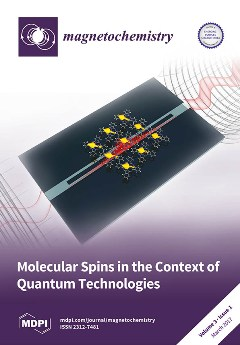The 1:1 reactions between hydrated lanthanide(III) nitrates and triethanolamine (teaH
3) in MeOH, in the absence of external bases, have provided access to the dinuclear complexes [Ln
2(NO
3)
4(teaH
2)
2] (Ln = Pr,
1; Ln = Gd,
2; Ln = Tb,
3; Ln = Dy,
4; Ln = Ho,
5) containing the singly deprotonated form of the ligand. Use of excess of the ligand in the same solvent gives mononuclear complexes containing the neutral ligand and the representative compound [Pr(NO
3)(teaH
3)
2](NO
3)
2 (
6) was characterized. The structures of the isomorphous complexes
1∙2MeOH,
2∙2MeOH and
4∙2MeOH were solved by single-crystal X-ray crystallography; the other two dinuclear complexes are proposed to be isostructural with
1,
2 and
4 based on elemental analyses, IR spectra and powder XRD patterns. The IR spectra of
1–
6 are discussed in terms of structural features of the complexes. The two Ln
III atoms in centrosymmetric
1∙2MeOH,
2∙2MeOH and
4∙2MeOH are doubly bridged by the deprotonated oxygen atoms of the two η
1:η
1:η
1:η
2:μ
2 teaH
2− ligands. The teaH
2− nitrogen atom and six terminal oxygen atoms (two from the neutral hydroxyl groups of teaH
2− and four from two slightly anisobidentate chelating nitrato groups) complete 9-coordination at each 4f-metal center. The coordination geometries of the metal ions are spherical-relaxed capped cubic (
1∙2MeOH), Johnson tricapped trigonal prismatic (
2∙2MeOH) and spherical capped square antiprismatic (
4·2MeOH). O–H∙∙∙O H bonds create chains parallel to the
a axis. The cation of
6 has crystallographic two fold symmetry and the rotation axis passes through the Pr
III atom, the nitrogen atom of the coordinated nitrato group and the non-coordinated oxygen atom of the nitrato ligand. The metal ion is bound to the two η
1:η
1:η
1:η
1 teaH
3 ligands and to one bidentate chelating nitrato group. The 10-coordinate Pr
III atom has a sphenocoronal coordination geometry. Several H bonds are responsible for the formation of a 3D architecture in the crystal structure of
6. Complexes
1–
6 are new members of a small family of homometallic Ln
III complexes containing various forms of triethanolamine as ligands. Dc magnetic susceptibility studies in the 2–300 K range reveal the presence of a weak to moderate intramolecular antiferromagnetic exchange interaction (
J = −0.30(2) cm
−1 based on the spin Hamiltonian
) for
2 and probably weak antiferromagnetic exchange interactions within the molecules of
3–
5. The antiferromagnetic Gd
III∙∙∙Gd
III interaction in
2 is discussed in terms of known magnetostructural correlations for complexes possessing the {Gd
2(μ
2-OR)
2}
4+ core. Ac magnetic susceptibility measurements in zero dc field for
3–
5 do not show frequency dependent out-of-phase signals; this experimental fact is discussed and rationalized for complex
4 in terms of the magnetic anisotropy axis for each Dy
III center and the oblate electron density of the metal ion.
Full article





